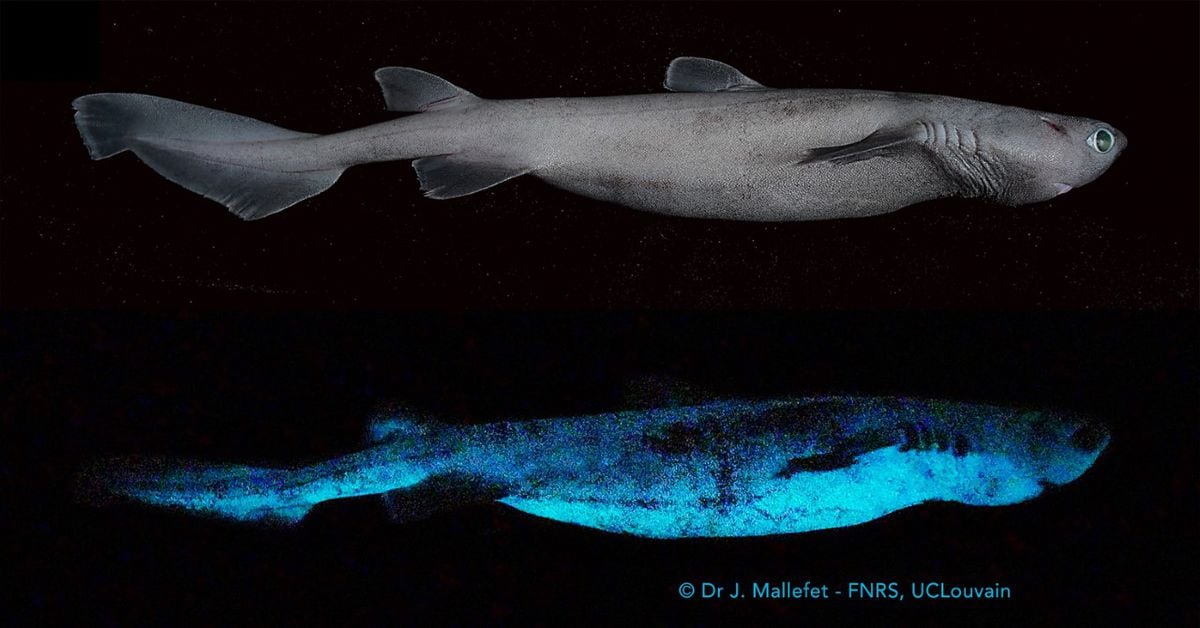The seabed is one of the most fascinating and least studied ecosystems on the planet.
At the top, between 200 and 1,000 meters deep, is the mesopelagic or twilight zone, where only a tiny amount of sunlight reaches.
This is the habitat where the three species of sharks that are capable of emitting light in the dark have been discovered.
A team of scientists from the Catholic University of Leuven (Belgium) traveled to New Zealand in January 2020 and spent a month on the high seas to study sharks in Chatham Rise, on the country's east coast.
Jérôme Mallefet, the leader of the expedition, has dedicated his entire life to studying these fish and is convinced that 11% of known shark species are bioluminescent.
His trip to New Zealand has allowed him to demonstrate it to the scientific community with three of these species, in a study published in the journal
Frontiers in Marine Science
.
Mallefet managed to capture specimens from three different families: the black-bellied lantern shark (
Etmopterus lucifer
), the southern lantern shark (
Etmopterus granulosus
) and the kite shark (
Dalatias licha
).
He transferred them to a water tank in a dark room on the ship, where his team was able to photograph the animals emitting a spectacular blue-green light.
"My dream was to see the
Dalatias licha
shining because no one in the world has seen it before, and I am convinced that it is the largest bioluminescent shark known so far," explains Mallefet in reference to the caroc shark, which can measure 180 cm and has become, thanks to this discovery, the largest luminous vertebrate in the world.
Bioluminescent animals have organs, photophores, which are what produce light.
In most of them this process is controlled by the nervous system.
But when the Belgian team of scientists studied the skin of captured sharks, where the photophores are found, they were surprised to find that they are the only animals whose light production is controlled by hormones.
"It took us a whole year to figure out how to stimulate the organ of light because all the nerve transmitters failed," says Mallefet.
Until they realized that melatonin, the same hormone that induces sleep in humans, was the trigger for light in sharks: “Melatonin is the one that triggers the production of light and the hormone alpha-MSH stops it. and it is a very slow process. "
The light produced by these sharks helps them hide their shadow and not alert other predators to their presence.
The next step for the researchers was to find out why sharks emit light.
Mallefet believes that the most plausible hypothesis is that it is a camouflage technique to survive in an area of the ocean where there are not many places to hide: “A small shark like these can be eaten by any large fish or other sharks.
If it is swimming and there is a blue light above it, when a predator passes under it it can very easily see the shadow of its prey contrasted with the light.
But if the shark's silhouette is also producing a blue light, the two lights are mixed.
It is called the hypothesis of the counter shadow, to shine to disappear and avoid being eaten by predators. "
The expedition of the Belgian team in the waters of New Zealand was made thanks to the NIWA, the National Institute of Maritime and Atmospheric Research of the country.
Darren Stevens is the expert fisheries scientist who was in charge of the vessel.
In his career he has caught many extraordinary fish (including two giant squids) but he never expected that sharks he sees continually could glow in the dark.
“We have seen bacteria and algae that emit light, also squid that release bioluminescent ink, we have caught many small fish that live in the twilight zone that have the same quality, such as lantern fish that also have photophores, and of course the abyssal fish. which has an antenna that sticks out of its head that can be lit up to attract prey to its mouths… yes, I have seen many fish that glow, but I never imagined that some of the great sharks could do the same.
If you think of the stone shark, which measures 1.8 meters and weighs up to 30 kilos, they are large and impressive animals, discovering that they can communicate by bioluminescence is incredible ”.
Stevens agrees with the Belgian researcher Jérôme Mallefet that the discovery of these sharks can help to understand the role of bioluminescence in the seabed.
In the animal kingdom 80% of bioluminescence is found in the oceans and the only vertebrates that can produce light are those that live in salt water.
"5% of the oceans is the surface of the sea and the remaining 95% constitutes the bottom of the sea, it is the largest habitat in the world and we know almost nothing about it," says Mallefet with a wide smile, hoping that he can participate. on another maritime expedition once the pandemic has been controlled.
His dream is to continue investigating the dark areas of the ocean and find out if, as he believes, bioluminescence is a form of communication for the inhabitants of the deep.
You can follow
MATERIA
on
,
and
, or sign up here to receive
our weekly newsletter
.






/cloudfront-eu-central-1.images.arcpublishing.com/prisa/2C5HI6YHNFHDLJSBNWHOIAS2AE.jpeg)



